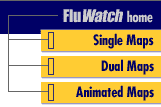Common menu bar links
E-mail this page
Fluwatch
Overall influenza activity in Canada remains low, similar to the previous week
During week 02, influenza activity levels in Canada remained fairly low overall; with most indicators having remained similar to, or decreased from the previous week. In week 02, 7 influenza surveillance regions (in ON, SK, AB and BC) reported localized influenza activity, while the rest reported either no activity (n=26) or sporadic activity (n=23)(see map). In week 02, the number of specimens that tested positive for influenza declined to 6.1% (260/4281). Of the influenza detections to date, 79% were influenza A and 21% were influenza B(see table). Influenza A detections predominated in most provinces except in AB, MB, NB and NS. This week, the ILI consultation rate declined to 15 ILI consultations per 1,000 patient visits (see ILI graph), which is below the expected range for this week. Note however that the sentinel response rate was also low at 60%. Six new influenza outbreaks were reported in week 02 from AB, BC and ON: 5 were in LTCF's and 1 was in another type of facility.
Antigenic Characterization:
The National Microbiology Laboratory (NML) has characterized 176 influenza viruses for the 2007-2008 influenza season: 119 A(H1N1), 12 A(H3N2) and 45 B viruses. All influenza A(H1N1) viruses were antigenically similar to A/Solomon Islands/3/2006. Of the 12 influenza A(H3N2) viruses characterized, 5 were antigenically similar to A/Wisconsin/67/2005 and 7 were antigenically similar to A/Brisbane/10/2007. One of the 5 A/Wisconsin-like viruses had reduced titer to A/Wisconsin/67/2005 reference antiserum. Of the 45 influenza B isolates characterized, 3 were antigenically similar to B/Malaysia/2506/2004 and 42 were antigenically similar to B/Florida/4/2006 (belonging to the B/Yamagata lineage) (see pie chart).
Antiviral Resistance:
Since the start of the season, the NML has tested 106 influenza A isolates (89 H1N1 and 17 H3N2) for amantadine resistance and found that 15 (88.2%) of the 17 H3N2 isolates were resistant to amantadine and 3 (3.4%) of 89 H1N1 isolates was resistant (see recommendation from the 2006-2007 influenza season below).
NML tested 92 influenza isolates for oseltamivir (Tamiflu) resistance and found that one isolate (1.1%) was resistant to oseltamivir. The resistant virus (H1N1 subtype) was identified in an infant who recently arrived in Canada from Sudan. It is thought that the patient likely contracted influenza in Sudan, and became ill within days of his arrival in Canada. It is unlikely that the patient had been treated with oseltamivir. Viruses that are resistant to neuraminidase inhibitor drugs have been detected in the past in untreated individuals.
Influenza-associated Paediatric Hospitalizations:
This week, no new laboratory-confirmed influenza-associated paediatric hospitalizations were reported through the Immunization Monitoring Program Active (IMPACT) network. To date, 21 hospitalizations have reported so far and all have been due to influenza A. The proportion of cases to date by age group are as follows: 24% each among 6-23 month olds, 2-4 year-olds, and 5-9 year-olds; 14% each among 0-5 month olds and 10-16 year-olds.
International:
WHO: During week 52 of 2007 and week 1 of 2008, the level of overall influenza activity in the world remained low. An increase in the number of influenza viruses detected was observed in some countries in the northern hemisphere, where mostly influenza A (H1N1) circulated.
CDC: During week 01, influenza activity continued to increase in the United States. State reporting of activity levels were as follows: 1 widespread, 10 regional, 12 local, 26 sporadic and 1 no activity. The proportion of specimens that tested positive for influenza virus increased to 7.2% this week. The majority of influenza detections to date were for influenza A viruses (87%). Since September 30, 2007, CDC antigenically characterized 114 influenza viruses: 67 influenza A(H1) (all A/Solomon Islands/3/2006), 19 influenza A(H3) (4 A/Wisconsin/67/2005-like and 14 A/Brisbane/10/2007-like, and 1 showed somewhat reduced titers with antisera produced against A/Wisconsin and A/Brisbane), and 28 influenza B viruses (3 belonging to the B/Victoria and 25 B/Yamagata lineage). To date this season, 1 influenza-associated pediatric death has been reported to the CDC (in week 48).
EISS: During week 2 of 2008 there was a substantial increase in influenza activity (mainly in western European countries) compared to the previous week where only 7 countries reported increased levels of influenza activity. The rest of Europe reported low levels of influenza activity. Influenza A(H1) is the dominant virus strain circulating in Europe this season and there is a good match between the strain and the corresponding vaccine strain A/Solomon Island/3/2006 which is included in the 2007-2008 vaccine.
Human Avian Influenza: Since 12 January 2008, the WHO reported 1 additional case of H5N1 avian influenza infection in Indonesia. The case is a 32-year-old female from Banten Province who developed symptoms on 3 January, was hospitalized on 9 January and died on 10 January.
Recommendation for the Use of Amantadine for Treatment and Prevention of Influenza
The Public Health Agency of Canada does not recommend the use of amantadine for treatment or prevention of influenza for the 2006-2007 season. This recommendation will be revisited if new information becomes available.
Total number of influenza tests performed and number of positive tests by province/territory of testing laboratory, Canada, 2007-2008
| Province
of reporting laboratories |
Report
Period: January 6 to January 12, 2008 |
Season
to Date: August 26, 2007 to January 12, 2008 |
||||||
| Total
# Influenza Tests |
# of Positive Tests | Total
# Influenza Tests |
# of Positive Tests | |||||
| Influenza A | Influenza B | Total | Influenza A | Influenza B | Total | |||
| NL | 32 | 8 | 0 | 8 | 184 | 13 | 0 | 13 |
| PE | 1 | 0 | 0 | 0 | 31 | 0 | 0 | 0 |
| NS | 22 | 0 | 0 | 0 | 214 | 0 | 1 | 1 |
| NB | 33 | 0 | 1 | 1 | 252 | 0 | 1 | 1 |
| QC | 815 | 26 | 2 | 28 | 6487 | 76 | 10 | 86 |
| ON | 1281 | 85 | 9 | 94 | 9580 | 470 | 15 | 485 |
| MB | 650 | 0 | 0 | 0 | 1358 | 0 | 1 | 1 |
| SK | 218 | 7 | 2 | 9 | 2104 | 33 | 18 | 51 |
| AB | 1099 | 33 | 41 | 74 | 11834 | 76 | 141 | 217 |
| BC | 130 | 39 | 7 | 46 | 948 | 99 | 17 | 116 |
| Canada | 4281 | 198 | 62 | 260 | 32992 | 767 | 204 | 971 |
Specimens from NT, YT, and NU are sent to reference laboratories in other provinces.
Note: Cumulative data includes updates to previous weeks; due to reporting delays, the sum of weekly report totals do not add up to cumulative totals.
Abbreviations: Newfoundland/Labrador (NL), Prince Edward Island (PE), New Brunswick (NB), Nova Scotia (NS), Quebec (QC), Ontario (ON), Manitoba (MB), Saskatchewan (SK), Alberta (AB), British Columbia (BC), Yukon (YT), Northwest Territories (NT), Nunavut (NU)
Respiratory virus laboratory detections in Canada, by geographic
regions, are available weekly on the following website:
<http://www.phac-aspc.gc.ca/bid-bmi/dsd-dsm/rvdi-divr/index-eng.php>
Number of influenza surveillance regions† reporting widespread or localized influenza activity, Canada, by report week, 2007-2008 (N=54)
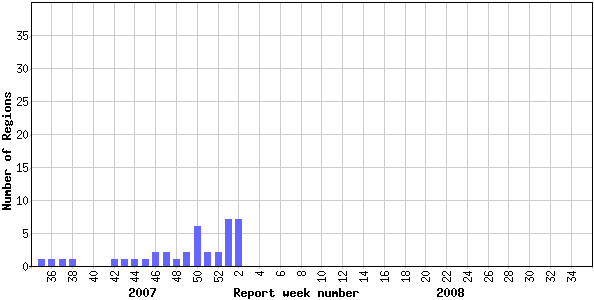
![]()
† sub-regions within the province or territory as defined by the provincial/territorial epidemiologist. Graph may change as late returns come in.
Influenza
Activity Level by Provincial and Territorial |
||||||||||||
|
||||||||||||
Note: Influenza activity levels, as represented on this map, are assigned and reported by Provincial and Territorial Ministries of Health, based on laboratory confirmations, sentinel ILI rates (see graphs and tables) and outbreaks. Please refer to detailed definitions. For areas where no data is reported, late reports from these provinces and territories will appear on the FluWatch website. Select single maps by report week to get this updated information.
<http://dsol-smed.phac-aspc.gc.ca/dsol-smed/fluwatch/fluwatch.phtml?lang=e>
Click on the map to view provinces/territories and maps for other weeks.
Influenza tests reported and percentage of tests positive, Canada, by report week, 2007-2008
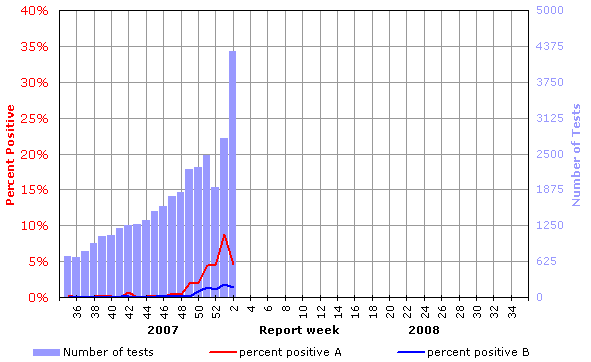
Percent positive influenza tests, compared to other respiratory viruses, Canada, by reporting week, 2007-2008
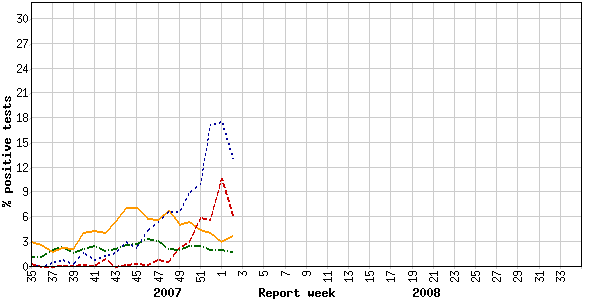
![]()
Influenza strain characterization, Canada, cumulative, 2007-2008 influenza season by the Respiratory Viruses Section at the National Microbiology Laboratory
[N=176]
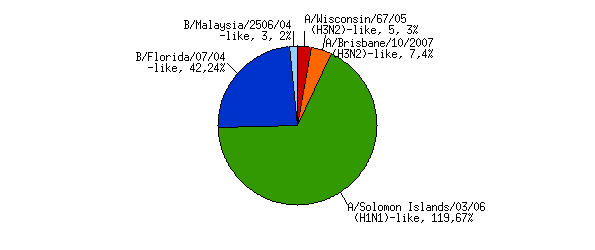
{Strain characterization, number identified, per cent of total number}
NACI recommends that the trivalent vaccine for the 2007-2008 season in Canada contain A/Solomon Islands/3/2006 (H1N1)-like virus; an A/Wisconsin/67/2005 (H3N2)-like virus; and a B/Malaysia/2506/2004-like virus.
Influenza-like illness (ILI) consultation rates, Canada, by report week, 2007-2008 compared to 1996/97 through to 2006/07 seasons

![]()
Note: No data available for mean rate in previous years for weeks 19 to 39 (1996-1997 through 2002-2003 seasons).
Number of New Outbreaks in Long Term Care Facilities, Canada, by Report Week, 2007-2008

![]()
Please note that the above graphs may change as late returns come in.


